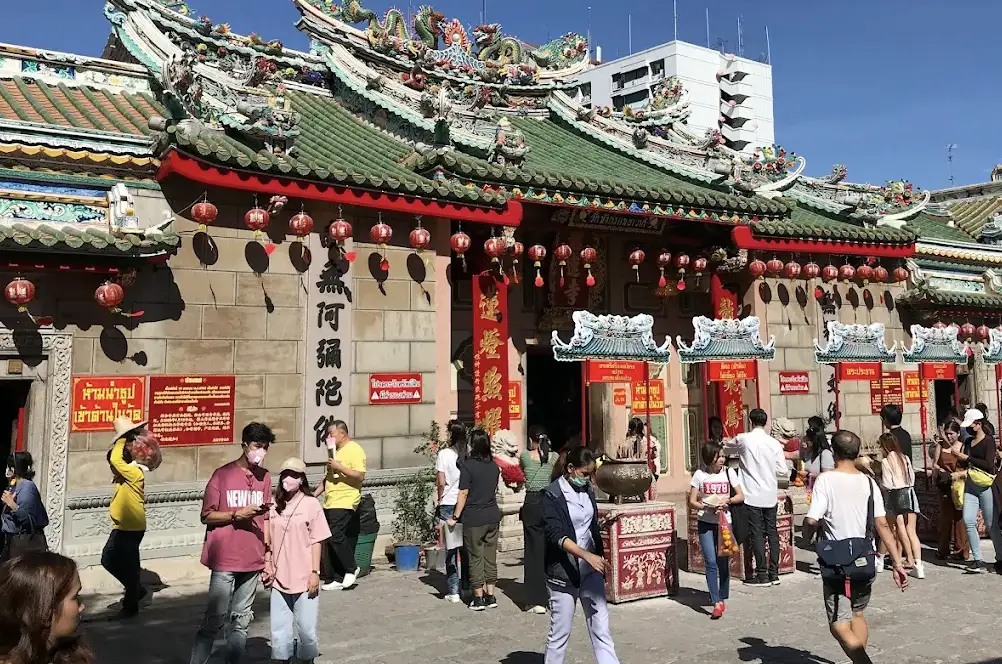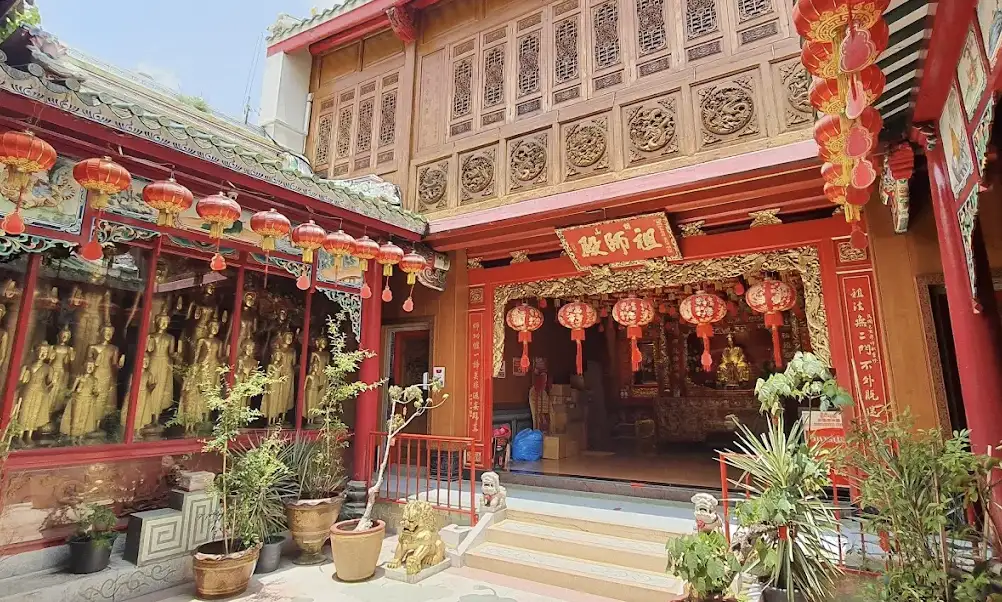As a traveler drawn to the cultural and spiritual heart of a city, my visit to Wat Mangkon Kamalawat in Bangkok’s vibrant Yaowarat Chinatown during June 2025 was a deeply enriching experience. Nestled along Charoen Krung Road in the Samphanthawong district, this Chinese Buddhist temple, also known as the “Dragon Lotus Temple,” is the largest and most significant Chinese temple in Thailand. With its intricate architecture, serene atmosphere, and rich Thai-Chinese heritage, it offers a tranquil contrast to the bustling night market nearby. Here’s my personal review of Wat Mangkon Kamalawat, written as an explorer immersing myself in this sacred gem, woven with insights from recent reviews for authenticity.
Arrival: A Gateway to Tranquility
Stepping into Wat Mangkon Kamalawat felt like crossing into a peaceful sanctuary amid the chaos of Yaowarat’s neon-lit streets. I reached the temple easily via the MRT, getting off at Wat Mangkon station, just a two-minute walk away. The temple’s vibrant entrance, marked by a towering Chinese gate adorned with dragons and red lanterns, was striking. The scent of incense and the soft hum of prayers greeted me as I entered, instantly calming the senses after navigating Chinatown’s crowded sidewalks.

The temple, built in 1871 during the reign of King Rama V, is a focal point for Bangkok’s Thai-Chinese community. Its courtyard was alive with devotees lighting incense and offering prayers, yet it retained a serene ambiance. A recent review described it as “a hidden gem that feels worlds away from the street food frenzy,” and I couldn’t agree more—it’s a place where time seems to slow down.
The Architecture: A Feast for the Eyes
Wat Mangkon Kamalawat’s design is a stunning blend of Chinese and Thai Buddhist styles. The main hall, with its sweeping tiled roof and ornate dragon motifs, is a masterpiece. Inside, golden Buddha statues, including the revered Phra Phuttha Chinorot, sit alongside Chinese deities like Kuan Yin, the goddess of mercy. The walls are adorned with intricate murals depicting Buddhist and Taoist tales, their vibrant colors glowing under the soft light of lanterns. I was captivated by the detailed wood carvings and porcelain tiles, which a review called “a testament to Chinese craftsmanship.”

The temple complex includes smaller shrines dedicated to various deities, each with its own altar piled with offerings of flowers, fruits, and incense. The Dragon Lotus Shrine, from which the temple gets its name, is particularly striking, with a lotus-shaped altar surrounded by dragon sculptures. Wandering through the courtyards, I noticed the temple’s compact yet layered layout, making it easy to explore without feeling overwhelmed. A Tripadvisor review noted the “peaceful nooks” perfect for quiet reflection, and I found myself lingering by a small fountain to soak in the calm.
The Rituals: A Glimpse into Devotion
One of the highlights was observing the temple’s rituals. Devotees, mostly locals, performed prayers with incense sticks, bowing before altars and shaking kau chim (fortune sticks) for insights into their future. I followed suit, guided by a friendly monk who explained the process in broken English. Shaking the bamboo container until a stick fell out, I received a fortune slip (20 baht donation), which a temple volunteer translated as a message of prosperity—a fun and meaningful keepsake. A review mentioned the fortune-telling as a “unique cultural experience,” though some noted it’s best to visit during festivals like Chinese New Year (January 29, 2025) for livelier ceremonies, including dragon dances I’d heard about in recent posts.
The temple is a spiritual hub, especially for blessings related to health, love, and success, which explains why it’s packed with worshippers, as noted in a blog post about Yaowarat’s cultural sites. During my visit, I saw families praying together and offerings for the recent Lunar New Year, adding a festive touch with extra red decorations honoring the Year of the Snake.
The Atmosphere: Spiritual and Welcoming
The temple’s atmosphere is its spiritual core—a serene haven that contrasts sharply with Yaowarat’s chaotic energy. Despite being a popular stop for tourists, it feels authentic, with locals outnumbering visitors during my visit. The air was filled with the gentle clink of coins in donation boxes and the murmur of prayers, creating a soothing rhythm. A review praised its “welcoming vibe,” and I felt at ease wandering through, even as a non-Buddhist. Monks and volunteers were approachable, offering insights into the temple’s history when asked, though English is limited, so a guide or translation app can help.
The temple’s role in the community was evident, with notices about upcoming charity events, a nod to its cultural significance. It’s free to enter, but small donations (20–50 baht) for incense or fortune sticks are appreciated. A review advised respecting the sacred space by dressing modestly (shoulders and knees covered) and avoiding loud behavior, which I followed to blend in respectfully.
Nearby Attractions: Pairing with Chinatown’s Charms
Wat Mangkon Kamalawat is perfectly positioned to explore Yaowarat’s night market, just steps away. After my visit, I dove into the street food scene, grabbing guay chub at Nai Ek Roll Noodle and mango sticky rice from a nearby stall. The temple’s proximity to Sampeng Market, a bustling alley for souvenirs, and Let’s Relax Spa at I’m Chinatown made it easy to craft a full evening. A review suggested combining the temple visit with a Chinatown food tour, which I’d try next time to deepen the experience.
Tips for Visiting Wat Mangkon Kamalawat
Drawing from my visit and traveler insights, here’s how to enjoy the temple:
- Visit in the Morning or Evening: The temple is open from 6 AM to 6 PM. Early mornings are quieter, while evenings pair well with Yaowarat’s night market.
- Dress Modestly: Cover shoulders and knees to show respect. Sarongs are available to borrow if needed.
- Bring Cash: Small donations (20–50 baht) for incense or fortune sticks are cash-only.
- Use MRT: Wat Mangkon station is a 2-minute walk, the easiest way to arrive. Avoid peak-hour taxis due to traffic.
- Respect Rituals: Keep noise low and avoid photographing active worshippers to honor the sacred space.
- Plan for Festivals: Chinese New Year or Vegetarian Festival (October) offers vibrant ceremonies, but expect larger crowds.
Final Take: A Cultural Must-See
Wat Mangkon Kamalawat is a serene, stunning gem that captures the soul of Bangkok’s Thai-Chinese heritage. Its intricate architecture, heartfelt rituals, and tranquil atmosphere make it a perfect counterpoint to Yaowarat’s lively streets. Whether you’re seeking spiritual reflection or cultural immersion, it’s a must-visit. As one reviewer put it, “It’s where you feel the heartbeat of Chinatown’s history.”
Would I return? Definitely. Next time, I’d visit during Chinese New Year for the dragon dances and try a guided tour to learn more about its history. If you’re in Bangkok, Wat Mangkon Kamalawat is a cultural treasure not to miss. Come with respect, an open heart, and a camera for the stunning details.
